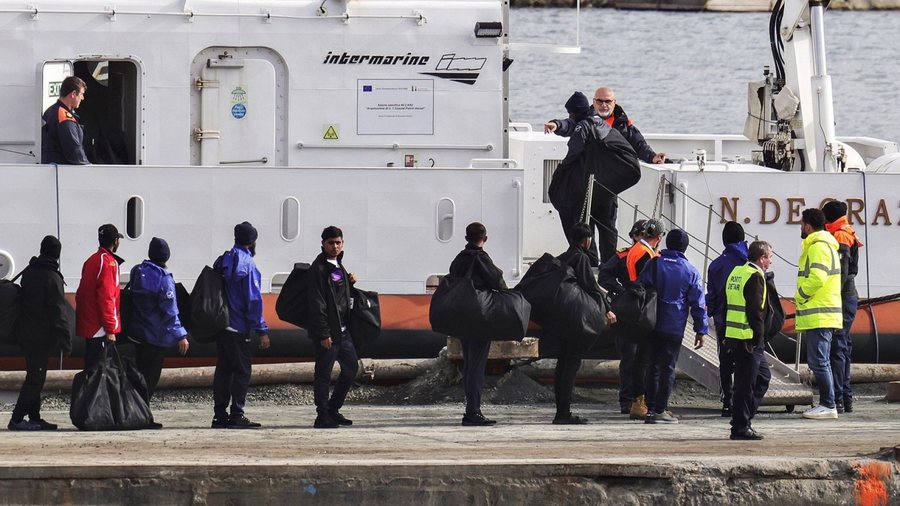The number of asylum applications in the European Union exceeds 1 million for the second year in a row!

The number of asylum applications registered in the European Union, Norway and Switzerland decreased by 11% in 2024, but remained above one million for the second consecutive year, according to the annual report published by the European Union Agency for Asylum (EUAA) on Monday morning.
In total, 1,014,420 applications for international protection were filed last year, compared to 1,143,437 applications registered in 2023.
Notably, the report shows that almost half (48%) of the one million applications were submitted by nationals with historically low chances of a successful decision, suggesting that they are likely to be ultimately rejected by national authorities.
The trend is set to compound repeated concerns from EU member states, which have urged Brussels to reform current legislation to speed up the deportation of rejected asylum seekers, such as economic migrants who come to the continent seeking better living conditions rather than escaping persecution or mistreatment.
The European Commission has approved the controversial idea of building camps (also known as "return hubs") outside EU territory to transfer those whose applications have been rejected. A revamped Return Directive is expected to be unveiled later this month.
Consistent with recent years, Syrians, Afghans, Venezuelans, Turks and Colombians represented the largest groups of applicants in 2024, according to the EUAA report.
Syrian claims (151,000) fell by 17% overall and by 24% in Germany, the main receiving country. The change is not directly related to the fall of Bashar al-Assad's autocracy, which only occurred in December and the effects of which have yet to fully materialize. Claims from Afghans (87,382), Turks (55,705) and Colombians (51,529) also fell.
On the other hand, applications in Venezuela rose to 73,187, a record high since at least 2014. The vast majority of them (90%) were filed in Spain.
As a result of the ongoing conflict in the Central Sahel region, Spain experienced exceptional migratory pressure in the Canary Islands. Applications from citizens of Mali (17,000) and Senegal (14,000) doubled in size from the previous year.
Ukrainians fleeing war in Russia filed 27,000 asylum applications in 2024, a 90% increase compared to 2023. The sharp increase is linked to the Temporary Protection Directive, a special regime that applies to Ukrainian citizens and is set to expire in March 2026. Applying for long-term asylum could offer a straightforward alternative.
In terms of destination countries, Germany remained clearly at the top with over 237,000 applications in 2024. However, the figure represents a 29% decrease compared to 2023.
Irregular migration was one of the issues that dominated the debate in February's parliamentary elections. Friedrich Merz, the conservative leader poised to become the next chancellor, has promised a dramatic tightening of Germany's migration and asylum laws.
Germany was followed by Spain (165,767 applications), Italy (158,867), France (158,730), Greece (73,688), Belgium (39,206) and the Netherlands (33,437) as the main destinations. Cyprus, a small island in the Mediterranean, saw the highest number of asylum applications per capita: one for every 138 inhabitants.
Meanwhile, Hungary received only 29 applications in 2024 due to its long-standing restrictions on the right to asylum, which the European Court of Justice ruled was an “unprecedented and extremely serious breach of EU law.” Hungary is currently subject to a multi-million euro fine from the ECJ, which is gradually deducted from the country’s share of the EU budget.
The recognition rate for successful applications remained virtually unchanged at 42% last year. Syrians (90%), Malians (84%), Eritreans (81%), Ukrainians (80%), Afghans (63%) and Somalis (60%) had the highest recognition rates.
The rate is far from uniform and varies depending on the country examining the application. For example, Afghans who applied in Greece had a recognition rate of 98%, while those who applied in Belgium had a much lower rate of 39%.
Countries with a low recognition rate below 20% included Turkey, Nigeria, Pakistan, Colombia, Tunisia, Morocco, Bangladesh, Georgia, Peru, Egypt and Venezuela.
The total number of pending cases was 981,000 at the end of 2024, a particularly high figure that matches the first peak during the 2016 migration crisis.
For years, the EU has tried to curb the number of applicants with a low recognition rate to avoid overwhelming authorities with cases that are unlikely to succeed. Brussels has signed EU-funded agreements with Tunisia, Egypt and Lebanon to strengthen border controls and prevent irregular migrants from leaving.
But a closer look at the 2024 statistics shows the limitations of this approach. According to Frontex, the EU border guard agency, there were 239,000 irregular border crossings last year, a 38% drop. That means the majority of the 1,014,420 asylum applications filed in 2024 came from people who arrived in the bloc through legal channels.

How has this month started for the major currencies?
The US dollar seems to have started this month on the decline, as compared to last week it lost points over the weekend, as it was bought today for 94.7 lek......

Morocco and Albania relaunch and deepen cooperation - Procedures for lifting short-term visas coming soon
Minister for Europe and Foreign Affairs, Igli Hasani, has begun an official visit to Morocco, where he was received by his counterpart, Nasser Bourita. This......

Rama, from Athens: We have a competitive labor market with Greece
Prime Minister Edi Rama was in Athens where he participated, together with some of his cabinet members, in the Job Fair. In his speech on the occasion, Rama......

Rama, at the Job Fair in Athens: You will find better opportunities in Albania
Today, the Job Fair is taking place in Athens, with the motto "Work and live where your heart is." Initially, Prime Minister Edi Rama, accompanied by members......

"Ukraine needs security guarantees" - Zelensky repeats demands after tensions with Trump
Following the Oval Office clash between United States President Donald Trump and Ukrainian leader Volodymyr Zelenskyy, the latter has repeated demands for......

Former Guard Command Turns into Museum 'Rama: It Will Be Added Value for Tirana. Opens Before Summer
Prime Minister Edi Rama, accompanied by the Deputy Mayor of Tirana, Anuela Ristani, inspected the works at the site of the former Republican Guard Command,......

EU, 100 billion euros for decarbonizing industry - Plan includes reducing energy bills for households and firms
The European Commission will make €100 billion available to support EU clean manufacturing, as part of the Clean Industrial Deal. The agreement is a key......

Tirana "leads" construction - In 2024, the approximate value of permits in the capital was estimated at around 690 million euros
The latest data shows that construction permits issued in Albania have reached a total value of 106.4 billion lek in 2024, or 1 billion euros, from 89.6......





















